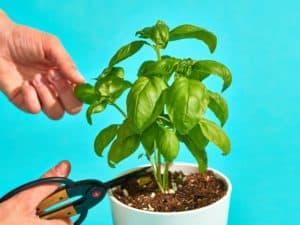
For many people, basil is one of the most widely used and beloved herbs in the kitchen – and in the garden! Learn how to easily trim basil.
It grows well, is fairly easy to maintain – and, most importantly, it’s one of the most delicious flavorings that one can add to a meal!
People who grow basil often tend to get really into growing basil – and with such a flavorful plant, who can blame them?
Especially given how many different types of basil there are to grow, and how easy it can be to grow!
At some point, growers will want to trim their basil plants.
However, if you’re in this situation, you might be worrying how you can do it smartly – getting enough for your needs, while still ensuring that you have a basil plant (or plants!) that will continue to produce delicious tasting basil leaves for years to come!
Well, no problem – this handy guide will tell you what you need to know to safely trim your basil plants! Read on to find out more!
Why Trim Basil?
First of all – why trim basil at all?
Well, there’s on very obvious answer – and it’s by far the best one. It tastes AMAZING! Seriously, basil is one of the greatest flavors in the kitchen.
The culinary world would be at a loss without basil – not only is it famous for use in Italian food, but basil is used around the world.
For example, Thai basil, used in much South Asian cuisine – which is of course a much different culinary tradition to that coming from Italy!
Basil is an amazingly versatile plant, with so many different varieties, that it’s likely possible to find a use for it, no matter what your culinary tastes are!
Secondly, trimming basil as actually a great way to promote growth!
This is great, as growing more basil is obviously a good thing. And even better – the way to make basil grow better also means that you’ve got fresh basil on hand – after all, you’ve just cut it off the plant! USe basil to get more basil – it’s almost magical!
Finally – you’d trim basil to remove the flowers that grow. Now, the flowers may be attractive, and encourage bees – but flowers aren’t really what anyone grows basil for.
No, we’re after the delicious leaves – and sadly, flowers on basil tend to inhibit the growth of leaves.
If the plant is putting energy into making these (admittedly beautiful) flowers, it has less to use in making the flavorful leaves that we all want. So, sadly, the flowers have to go!
Removing Flowers
Removing flowers from basil plants is actually really easy!
The best thing is to remove them before they get much chance to grow.
You’ll want to literally nip them in the bid – after all, the longer they spend growing, the more energy they’re spending on flowers, instead of leaves!
You can simply pinch them off with your bare hands. It’s best to do this as early as possible.
You can also obviously pinch or trim the flowers off once they’re grown – it will definitely help the plant out when it comes to producing leaves.
However, like all problems, it’s best taken care of before this. Of course, late is better than never – so if your basil plant has flowers already, don’t worry – just get them gone!
Well watered basil plants with decent amounts of sunlight and good soil with good drainage are obviously being well taken care of – and as such, won’t produce as many flowers.
The better you treat it, the better and bigger leaves it can produce!
However, a basil plant developing flowers doesn’t mean that you’ve done anything wrong – after all, flowers are what most plants tend to make, sooner or later!
By mid summer, most basil plants will have started to make flowers – so ideally, you’ll want to pay attention to them before that, and get rid of any buds as soon as you can.
Trimming For Harvest Or Better Growth
You don’t even particularly need tools to harvest basil leaves. The plant will be perfectly fine if you pull leaves off by hand.
And of course, your hands will smell great afterwards – it would almost be a shame to wash them! Of course, be careful, and gentle – you don’t want to damage your precious plant.
If you prefer to use tools, an inexpensive set of hand pruners or herb snips will do the job just fine.
If you’re doing some heavy cutting, it’s probably best to use tools – they’ll cut through the plant more easily, and will mean you’re running less risk of damaging the stems of the plant.
The first thing to do is to inspect the plant to find the best place to cut. You’ll be looking to cut leaves from the top of the plant, cutting stems back to where new growth is forming.
You’ll usually see two tiny leaf buds on the plant – this is new growth.
Don’t remove this, as it’s completely detrimental to the purpose of cutting to promote growth. And of course, what’s the point of using new, tiny leaves in cooking?
No, that’s what the big leaves are for – they’re the whole reason we’re doing this! So, instead, cut a quarter inch to half an inch above these new buds. This will let them get more light, enabling them to grow!
And of course – you’ll have the delicious leaves that are already grown, ready to use! Win-win!
Preservation
You may have more basil on hand than you can really use at once, or before it starts to decay. So, you should take some steps to preserve the freshly cut basil!
You can dry the basil out, either using a dehydrator, or by bundling the cut basil together with some twine and leaving them in a warm room away from sunlight for a few weeks.
This is a classic, centuries old way of preserving basil, at the loss of some flavor.
Or, you can freeze your basil – it’s perfectly fine to do this, although it may darken. Blanching them for a few seconds in boiling water can help them to preserve their color.
Of course, nothing will come close to the taste of freshly picked basil – but it’s better to preserve than to waste!
Conclusion
Basil is an amazing herb! Hopefully, this article has taught you about trimming your plant, and what to do with the leaves after trimming!


